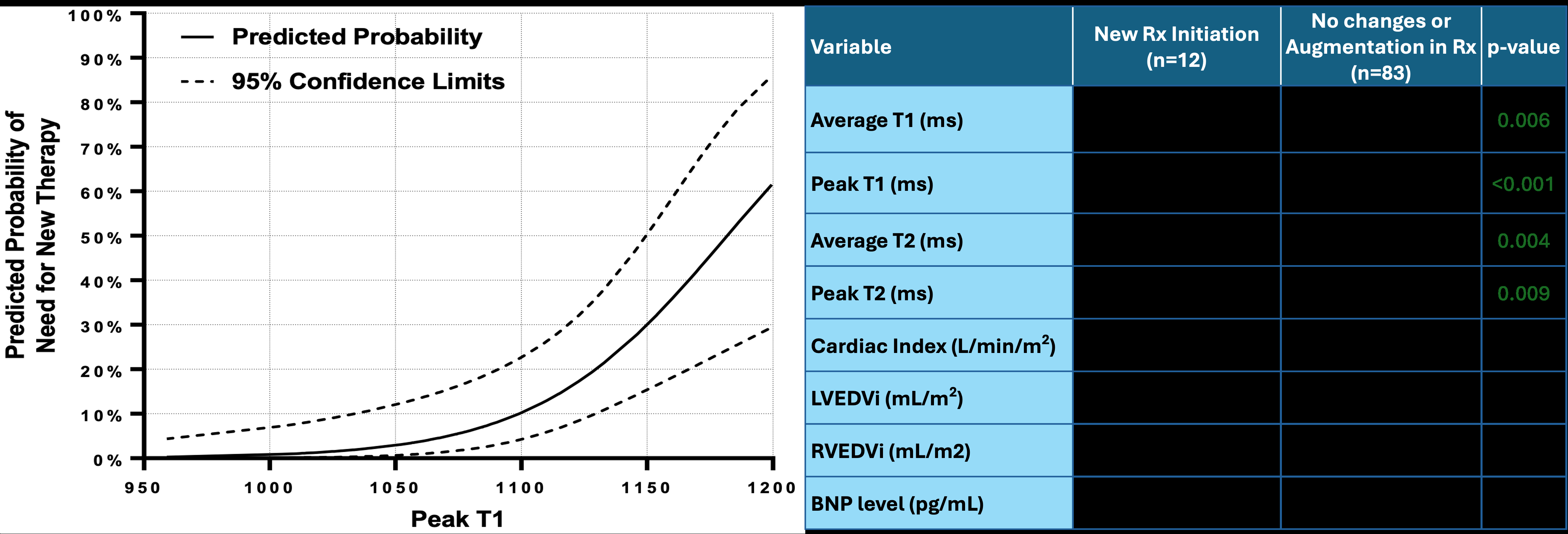Final ID: Su2032
CMR can discriminate need for biopsy and rejection therapy in children post heart transplant
Abstract Body (Do not enter title and authors here): Background:
Heart transplantation remains definitive therapy for children with heart failure, but the burden of acute graft rejection remains. While adult data has shown cardiac magnetic resonance (CMR) offers reliable, non-invasive identification of graft rejection1-3, endo-myocardial biopsy (EMB) continues to be the gold-standard in children.
Hypothesis:
CMR can establish the presence/absence of rejection, guiding need for EMB and rejection therapy.
Aims:
To assess the (1) strength of CMR parametric mapping in discriminating presence of rejection (defined as need for new therapy), and (2) the ability of CMR to identify patients without rejection, negating the need for EMB.
Methods:
Pediatric heart transplant patients referred for EMB underwent concurrent noncontrast CMR with volumetry, flows, MOLLI T1 and T2 parametric mapping at 1.5T. Average and peak segmental native T1 and T2 were measured in 6 slices, and regions of sub-segmental ‘hotspot’ elevation (3 continuous voxels T1>1050 ms or T2>60 ms) were identified. Rejection treatment was per institutional protocol, blinded to CMR results, categorized as (A)new IV therapy, (B)oral augmentation of maintenance, or (C) no change. Sensitivity, specificity and ROC analyses were performed.
Results:
95 encounters in 34 patients (median age 13.1y (IQR 7.5-16.3), BSA 1.37 m2 (1.1-1.6), 47% female) were completed, with treatment groups A 13%, B 5%, and C 82%. Significantly higher T1 and T2 values were found in the rejection groups. ROC curve analysis identified elevated peak T1 levels as the strongest predictor of rejection (AUC = 0.848, 95% CI: 0.746, 0.950, p<0.001), with optimal cutoff T1 >1099 ms. Subsegmental hotspots were present in all encounters with rejection requiring new therapy (100% sensitivity), however the type/ number of hotspots did not correlate with rejection. New rejection therapy was not initiated in any patient encounter without hotspots (NPV 100%).
Conclusions:
Elevated segmental T1 CMR values can identify children with graft rejection, and absence of subsegmental hotspot elevations can reliably identify patients without rejection. CMR is a promising non-invasive test to aid in graft surveillance and direct invasive testing and therapy.
Heart transplantation remains definitive therapy for children with heart failure, but the burden of acute graft rejection remains. While adult data has shown cardiac magnetic resonance (CMR) offers reliable, non-invasive identification of graft rejection1-3, endo-myocardial biopsy (EMB) continues to be the gold-standard in children.
Hypothesis:
CMR can establish the presence/absence of rejection, guiding need for EMB and rejection therapy.
Aims:
To assess the (1) strength of CMR parametric mapping in discriminating presence of rejection (defined as need for new therapy), and (2) the ability of CMR to identify patients without rejection, negating the need for EMB.
Methods:
Pediatric heart transplant patients referred for EMB underwent concurrent noncontrast CMR with volumetry, flows, MOLLI T1 and T2 parametric mapping at 1.5T. Average and peak segmental native T1 and T2 were measured in 6 slices, and regions of sub-segmental ‘hotspot’ elevation (3 continuous voxels T1>1050 ms or T2>60 ms) were identified. Rejection treatment was per institutional protocol, blinded to CMR results, categorized as (A)new IV therapy, (B)oral augmentation of maintenance, or (C) no change. Sensitivity, specificity and ROC analyses were performed.
Results:
95 encounters in 34 patients (median age 13.1y (IQR 7.5-16.3), BSA 1.37 m2 (1.1-1.6), 47% female) were completed, with treatment groups A 13%, B 5%, and C 82%. Significantly higher T1 and T2 values were found in the rejection groups. ROC curve analysis identified elevated peak T1 levels as the strongest predictor of rejection (AUC = 0.848, 95% CI: 0.746, 0.950, p<0.001), with optimal cutoff T1 >1099 ms. Subsegmental hotspots were present in all encounters with rejection requiring new therapy (100% sensitivity), however the type/ number of hotspots did not correlate with rejection. New rejection therapy was not initiated in any patient encounter without hotspots (NPV 100%).
Conclusions:
Elevated segmental T1 CMR values can identify children with graft rejection, and absence of subsegmental hotspot elevations can reliably identify patients without rejection. CMR is a promising non-invasive test to aid in graft surveillance and direct invasive testing and therapy.
More abstracts on this topic:
A Machine Learning Algorithm to Detect Pediatric Supraventricular Tachycardia Risk from Baseline ECGs
Early and late impact of the current organ allocation system in the United States
Arezoumand Amirhossein, Danala Gopichandh, Masnadi Khiabani Parisa, Ebert David, Behere Shashank
Adult heart transplant practice changes:Early and late impact of the current organ allocation system in the United States
Kawabori Masashi, Katsadouros Vasili, Johnson Anna, Chung Jin Woo, Sekela Michael, Birks Emma, Loebe Matthias

